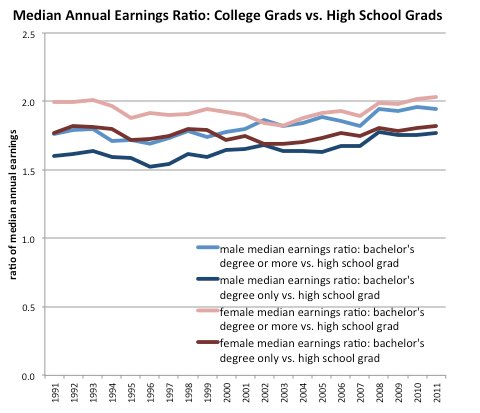
CATHERINE RAMPELL
Dollars to doughnuts.
I’ve written before about the growing wage premium for college degrees: how the wage gap between workers with a bachelor’s degree and workers with no more than a high school diploma has been growing over the years.
But that statistic captures only part of the income premium that people with a bachelor’s degree enjoy as a result of completing college.
As I report in an article in Wednesday’s paper, people with college diplomas are much more likely to get jobs, period, than people without the credential. Part of college graduates’ income premium, then, comes from the fact that they are just more likely to be employed in a typical week. They are probably more likely to work the number of desired hours they wish to work, too, according to Gary Burtless, a senior fellow at the Brookings Institution.
You can see this in the unemployment numbers: The jobless rate for people with a bachelor’s degree was 3.7 percent in January, versus 8.1 percent for those with no more than a high school diploma.
Census estimates of median annual earnings help capture the college income premium. In 2011, the median male college graduate earned 1.95 times as much as the median male whose highest educational attainment was a high school diploma. In 1991, that ratio was 1.76. For women, the ratio is up, but not by as much: It was 2.03 in 2011 versus 1.99 in 1991, and it dipped in the intervening years.
Here’s a chart showing these earnings ratios over the last two decades:
 Source: Census Bureau, Current Population Survey, Annual Social and Economic Supplements
Source: Census Bureau, Current Population Survey, Annual Social and Economic Supplements
When I’ve written about this subject before, I’ve been criticized for lumping in people with advanced degrees with workers with no more than a college diploma, when the job prospects for those two groups might be very different. But even if you compare the workers with no more than a college degree with workers with no more than a high school diploma, the ratio in their median annual earnings has still been rising. (The darker lines in the chart above refer to the ratio in annual median earnings for workers with exactly a college degree, and no further education, compared to workers with exactly a high school diploma; the lighter lines show the ratio for all college grads compared to those with exactly a high school diploma.)
By the way, the Census Bureau numbers refer only to workers who have at least some earnings; they exclude people who have no earnings at all. Since a higher percentage of college grads than high school grads have at least some annual earnings — and since this differential has increased over the last 20 years, particularly for men — then these Census earnings numbers will actually understate the increase in the total earnings premium from college completion, as Mr. Burtless noted to me in an e-mail.
If recent trends continue — with employers increasingly demanding that job candidates show up to their interview with a sheepskin in hand — we should expect that the wage and employment advantage conferred upon college grads will only grow.
College can bring a lot of debt, yes. But these figures serve as a reminder that college also brings huge returns relative to how you might otherwise invest your tuition money.
Article source: http://economix.blogs.nytimes.com/2013/02/19/college-premium-better-pay-better-prospects/?partner=rss&emc=rss